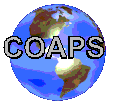



Shawn R. Smith
COARE Surface Meteorology DAC
Center for Ocean Atmospheric Prediction Studies
Florida State University
The quality control flags are single alphabetic characters for each data value indicating quality of that specific value. Only those variables with a qcindex have flag values (the qcindex is an integer pointer to the flag for a selected variable). The flags are:
A Original data had unknown units. The units indicated were determined using a climatology or other method.B Original data was out of the range bounds outlined (Table 1).
C Time data are not sequential or date/time not valid.
D Data failed T>=Tw>=Td test.
E Data failed resultant wind recomputation check. When the original data set includes the platform's speed and direction along with the platform relative wind speed and direction, recomputed earth relative wind speed and direction and compared to the reported earth relative wind speed and direction. A failed test occurs when the wind direction difference is > 10° or the wind speed difference is >5 m/s.
F Platform velocity unrealistic. Determined by platform position and speed data.
G Data are greater than 4 standard deviations from the monthly climatological means in the da Silva et al. (1994) COADS climatology. The test is only applied to pressure, temperature, sea temperature, relative humidity, and wind speed data.
H Discontinuity found in data
I Interesting feature found in data. More specific information on the feature is contained in the data reports. Examples include: hurricanes passing station, sharp sea water temperature gradients, strong convective events, etc.
J Data are of poor quality by visual inspection, DO NOT USE.
K Data suspect/use with caution - this flag applies when the data look to have obvious errors, but no specific reason for the error can be determined.
L Oceanographic platform passed over land/fixed platform moves dramatically.
M Known instrument malfunction.
N Flag currently not used.
O Flag currently not used.
P Position of platform or its movement are uncertain. Data should be used with caution.
Q Flag currently not used.
R Flag currently not used.
S Spike in the data. Usually one or two data values (sometimes up to 4 values) that are drastically out of the current data trend. Spikes occur for many reasons including power surges, typos, data logging problems, lightning strikes, etc.
T Flag currently not used.
U Flag currently not used.
V Flag currently not used.
W Flag currently not used.
X Flag currently not used.
Y Flag currently not used.
Z Data passed evaluation
Table 1: Range Bounds For Determining Use of Flag 'B' Variable Lower Bound Upper Bound Units OtherReference:
time 1-1-1980 12-31-1999 latitude -90 90 degrees longitude 0 359 degrees platform heading 0 359 degrees platform speed 0 15 m/s research vessels 0 0 m/s stationary buoys 0 2 m/s drifters plat. wind direction 0 360 degrees plat. wind speed 0 40 m/s wind direction 0 360 degrees wind speed 0 40 m/s pressure 950 1050 mb Sea level air temperature -10 40 š Celsius wet bulb temperature -10 40 š Celsius dew point temperature -10 40 š Celsius sea temperature 0 35 š Celsius relative humidity 0 100 percent radiation 0 1400 W/m2da Silva, A. M., C. C. Young, and S. Levitus, 1994: Atlas of Surface Marine Data, Volume 1: Algorithms and Procedures. NOAA Atlas Series. In press.